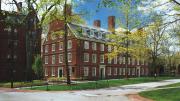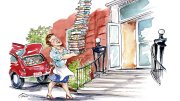Massachusetts Hall, for many people, is Harvard. It guides visitors through Johnston Gate into what is now Harvard Yard. Its compact design—pleasingly proportioned Early Georgian red brick with white trim, devoid of frills—defines the architectural idiom for much of the rest of this campus (and others).
Its history anticipates the University’s, too. A growing student body (“ye Sons of ye Prophets are now so increas’d”) had spilled over into “lodgings in the town,” spurring “uncomfortable Views of Mischeifs impending.” Accordingly, various building plans were drawn—literally—by Benjamin Wadsworth, a Fellow of the College (and later president), and by President John Leverett (a task modern presidents no longer need fulfill). Successive fundraising memorials to the General Assembly succeeded in extracting two tranches, for £1,500 and £2,000 (a chore very much on presidents’ agendas today). The construction was sufficiently far along for Commencement visitors to see much of the building in the summer of 1720. A novel feature was the “Apparatus Chamber,” the precursor to the vast scientific facilities today.
For all its welcome familiarity as Harvard’s oldest standing building, Mass Hall has no more resisted change than the burgeoning academy around it. The clock was added in 1725. Lecture rooms and laboratories replaced housing during a gut renovation in 1870. At an affectionate, gala bicentennial celebration in 1920 (addressed by President A. Lawrence Lowell and Massachusetts governor and U.S. vice president-elect Calvin Coolidge, among others), more than one speaker recalled the tradition of students fleeing dull classes via the fire escape. Its past as a dormitory, “a place to sleep in,” carried over as “that tradition of sleep remained after it was turned into a lecture hall.”
The building has witnessed rougher circumstances, too. After the College removed to Concord in 1775, Continental Army troops quartered on campus; two years later, Harvard granted permission to house imprisoned British officers in Mass Hall. In 1778, Harvard sent the Commonwealth a detailed account of claims for damage to its properties and stores—including the theft of Mass Hall’s metal fixtures—totaling £417.8.8. The still-solid building weathered the Civil War and World War I, but despite Lowell’s encomium to its thick brick walls and “solidity,” it suffered fire damage in 1924. The ensuing repairs restored the dorm rooms—until, emerging from the Great Depression and with world war threatening again, a subsequent remodeling, in 1939, created administrative spaces: the forerunner of today’s Mass Hall, with offices for the president and senior staff, topped by a residual floor of freshmen.
In this sense, Mass Hall has symbolized the University’s enduring passage through internal change and external storm: anchored in tradition, restless in intellectual ambition, adaptable to an uncertain world. So it is today, in the pandemic year of 2020.
And so it was from its inception, three centuries ago. President Leverett visited the General Court in November 1720 “to give Thanks unto Almighty God, who has inclined and Led the Government into and thro so great and Noble a Work, and then also to make our acknowledgements to your Excellency and Honours for this great Benefaction to the College….” Sadly, the following June 23, before the first graduation and accompanying revelries since Mass Hall’s completion, the Overseers had to vote that “there be a private Commencmt this year.” Why? “By reason of the present Spreading of the Small Pox.”









